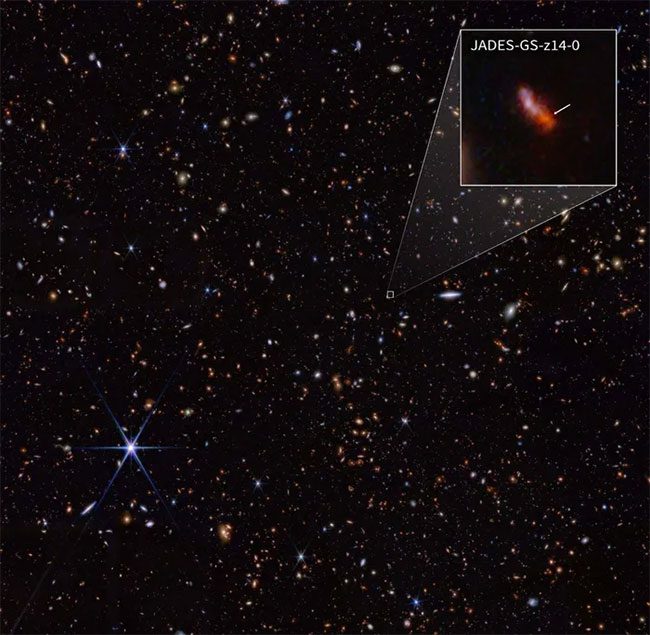The James Webb Space Telescope has ushered in a new era of scientific breakthroughs, providing images of distant regions of the universe and allowing humanity to look back in time.
On May 30, the National Aeronautics and Space Administration (NASA) announced that the James Webb Space Telescope has discovered the most distant galaxy observed to date.
This galaxy is a particularly bright star system that existed just 290 million years after the Big Bang.
Launched in July 2022, James Webb is the most powerful space telescope ever built. This telescope has opened a new era of scientific breakthroughs, providing images of distant regions of the universe and allowing humanity to look back in time.

The observation results of JADES-GS-z14-0 have overturned astronomical predictions about the earliest galaxies formed after the Big Bang 13.8 billion years ago. (Source: webbtelescope).
Researchers emphasize that this latest discovery by James Webb has profound implications for our understanding of the dawn of the universe.
In a joint statement, a group of international astronomers announced the first detection of the galaxy known as JADES-GS-z14-0 in early 2023.
However, they needed further observations to confirm that this galaxy is indeed the most distant one observed to date.
Stefano Carniani from the Scuola Normale Superiore in Italy and Kevin Hainline from the University of Arizona stated: “The source of light is incredibly bright, exceeding expectations for such a distant galaxy and is so close to another galaxy that they both appear to be part of a larger object.”
Before the light from the most distant galaxies reaches Earth, it stretches due to the expansion of the universe and shifts into the infrared region of the light spectrum, which the James Webb Telescope is equipped to detect with unprecedented clarity.
In October 2023 and January 2024, the research team conducted observations to confirm their hypothesis, using James Webb’s primary imaging instrument called NIRCam and the NIRSpec device to analyze the light spectrum from an object and determine its physical properties.
JADES-GS-z14-0 breaks the previous record of the oldest known galaxy, JADES-GS-z13-0, which existed 320 million years after the Big Bang.
After determining the age of the galaxy JADES-GS-z14-0 in January this year, Hainline expressed his astonishment. The researcher compared: “If the universe were a 2-hour movie, this galaxy would appear in the first 2 and a half minutes.”
Based on images, the galaxy JADES-GS-z14-0 is located 1,600 light-years away from Earth. According to researchers, the light from its stars indicates that this galaxy has a mass hundreds of millions of times that of the Sun. The scientific team questions how nature could create such a bright and massive galaxy in less than 300 million years.
Further analysis of the light emission shows the presence of oxygen, another astonishing discovery that proves the existence of many large and massive star generations before the galaxy was observed.
Thus, the observations of JADES-GS-z14-0 have overturned astronomical predictions about the earliest galaxies formed after the Big Bang 13.8 billion years ago.
Researchers noted that they have only observed a relatively small portion of the night sky, suggesting that in the coming years, more bright and earlier-formed galaxies are likely to be discovered.




















































